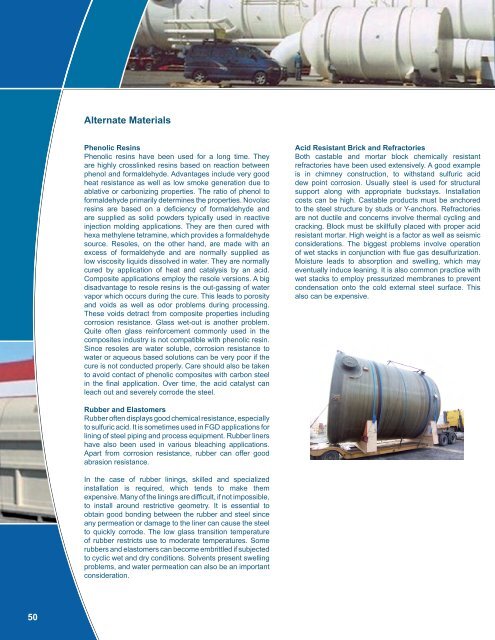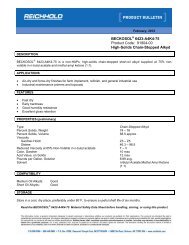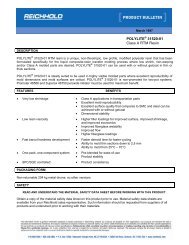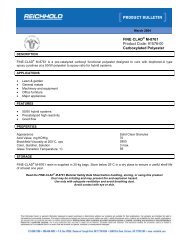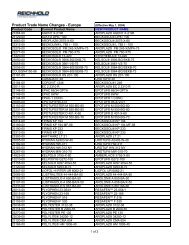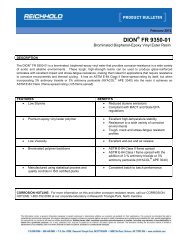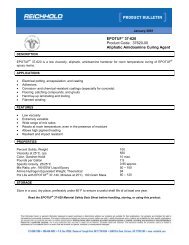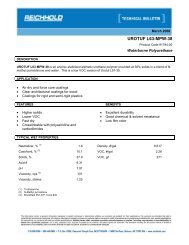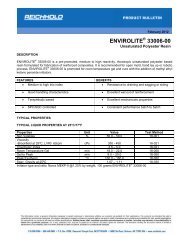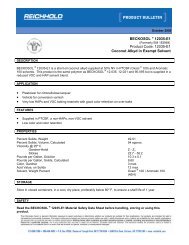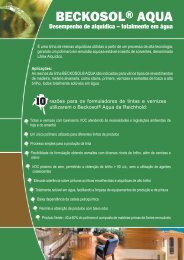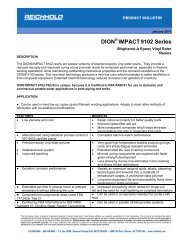CORROSION GUIDE 181108_new table content format ... - Reichhold
CORROSION GUIDE 181108_new table content format ... - Reichhold
CORROSION GUIDE 181108_new table content format ... - Reichhold
Create successful ePaper yourself
Turn your PDF publications into a flip-book with our unique Google optimized e-Paper software.
Alternate Materials<br />
Phenolic Resins<br />
Phenolic resins have been used for a long time. They<br />
are highly crosslinked resins based on reaction between<br />
phenol and formaldehyde. Advantages include very good<br />
heat resistance as well as low smoke generation due to<br />
ablative or carbonizing properties. The ratio of phenol to<br />
formaldehyde primarily determines the properties. Novolac<br />
resins are based on a defi ciency of formaldehyde and<br />
are supplied as solid powders typically used in reactive<br />
injection molding applications. They are then cured with<br />
hexa methylene tetramine, which provides a formaldehyde<br />
source. Resoles, on the other hand, are made with an<br />
excess of formaldehyde and are normally supplied as<br />
low viscosity liquids dissolved in water. They are normally<br />
cured by application of heat and catalysis by an acid.<br />
Composite applications employ the resole versions. A big<br />
disadvantage to resole resins is the out-gassing of water<br />
vapor which occurs during the cure. This leads to porosity<br />
and voids as well as odor problems during processing.<br />
These voids detract from composite properties including<br />
corrosion resistance. Glass wet-out is another problem.<br />
Quite often glass reinforcement commonly used in the<br />
composites industry is not compatible with phenolic resin.<br />
Since resoles are water soluble, corrosion resistance to<br />
water or aqueous based solutions can be very poor if the<br />
cure is not conducted properly. Care should also be taken<br />
to avoid contact of phenolic composites with carbon steel<br />
in the fi nal application. Over time, the acid catalyst can<br />
leach out and severely corrode the steel.<br />
Acid Resistant Brick and Refractories<br />
Both cas<strong>table</strong> and mortar block chemically resistant<br />
refractories have been used extensively. A good example<br />
is in chimney construction, to withstand sulfuric acid<br />
dew point corrosion. Usually steel is used for structural<br />
support along with appropriate buckstays. Installation<br />
costs can be high. Cas<strong>table</strong> products must be anchored<br />
to the steel structure by studs or Y-anchors. Refractories<br />
are not ductile and concerns involve thermal cycling and<br />
cracking. Block must be skillfully placed with proper acid<br />
resistant mortar. High weight is a factor as well as seismic<br />
considerations. The biggest problems involve operation<br />
of wet stacks in conjunction with fl ue gas desulfurization.<br />
Moisture leads to absorption and swelling, which may<br />
eventually induce leaning. It is also common practice with<br />
wet stacks to employ pressurized membranes to prevent<br />
condensation onto the cold external steel surface. This<br />
also can be expensive.<br />
Rubber and Elastomers<br />
Rubber often displays good chemical resistance, especially<br />
to sulfuric acid. It is sometimes used in FGD applications for<br />
lining of steel piping and process equipment. Rubber liners<br />
have also been used in various bleaching applications.<br />
Apart from corrosion resistance, rubber can offer good<br />
abrasion resistance.<br />
In the case of rubber linings, skilled and specialized<br />
installation is required, which tends to make them<br />
expensive. Many of the linings are diffi cult, if not impossible,<br />
to install around restrictive geometry. It is essential to<br />
obtain good bonding between the rubber and steel since<br />
any permeation or damage to the liner can cause the steel<br />
to quickly corrode. The low glass transition temperature<br />
of rubber restricts use to moderate temperatures. Some<br />
rubbers and elastomers can become embrittled if subjected<br />
to cyclic wet and dry conditions. Solvents present swelling<br />
problems, and water permeation can also be an important<br />
consideration.<br />
50


